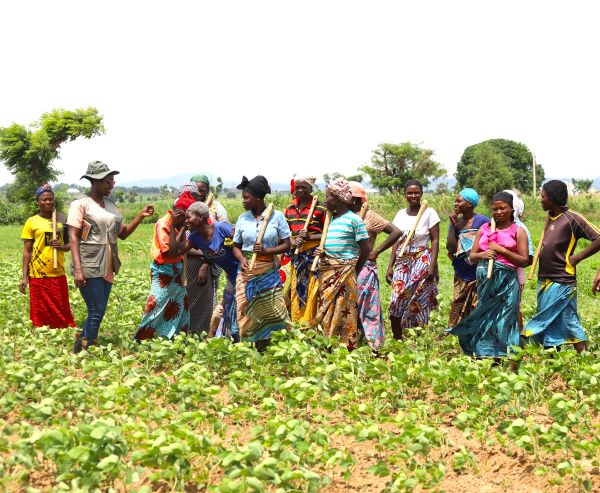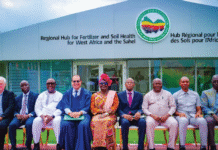Dr Stella Kabiri, Lead Regenerative Agriculture at Sasakawa Africa Association
Can Africa’s farmers produce “more with less”? Recently, profound global food supply shocks, intensified by climate change, the war in Ukraine and the effects of the pandemic, have disproportionately affected poorer and vulnerable populations in Africa. The Food Crises 2022 Global report revealed over 140 million people in Africa are confronted with food insecurity. This has sparked an array of concerns around the ability of the continent to feed its growing population.
Most of Africa’s farmers cannot afford agro-inputs, including fertilizers, and they face high pricing or rationing. Yet, profitability from using agro-inputs on major crops has been reduced, further threatening food security. At the continental level, achieving sustainable and resilient food systems requires a comprehensive plan to enhance agricultural productivity, improve infrastructure, foster access to global markets, and implement climate-resilient practices. However, at the farm level, it has become evident that Regenerative Agriculture (RA) may bear promise in innovative soil fertility management. This could propel the transformation of agri-food systems amidst current challenges.
Recently, RA has become popular as an initiative to make farmland more productive, sustainable, and resilient. This is achieved by increasing soil fertility and improving soil health by boosting biodiversity and the ecosystem as a vital aspect of food production. Regenerative agricultural systems manage naturally occurring beneficial soil–plant interactions and enhance the sustainability of farmland and food systems.
For over three decades, Sasakawa Africa Association (SAA), an international NGO, has actively promoted improved crop varieties and good agricultural practices that increase crop productivity for smallholder farmers in sub-Saharan Africa. Building on this foundation, in the past two years, SAA has also been advocating for and demonstrating RA practices to enhance the health of degraded soils.
SAA now stands as a prime exemplar of RA in action, through advocacy for crops that are water and nutrient use efficient and integrating minimum tillage and diverse cereal-legume cropping systems, that fosters not only soil health, but also a thriving tapestry of micro and macro flora and fauna – a cornerstone of vibrant ecosystems often overlooked. Additionally, a resolute stand on responsible agro-chemical use underscores its commitment to human well-being and ecological equilibrium. Through focusing on innovative fertilizer applications aimed at curbing nitrous oxide emissions, it underscores the resolve to tackle climate change at its core.Through the promotion of these practices, SAA has observed that in combination of improved varieties, RA reduces the overall cost of production for smallholder farmers while increasing net returns on investment. For example, in Ethiopia, where teff farmers culturally plough as much as seven times in a season, minimum tillage has reduced mechanical soil disturbance while reducing ploughing costs significantly. SAA in Ethiopia is promoting different composting technologies, including vermicomposting that expedites the decomposition process. Consequently, beneficiary farmers in Ethiopia have reduced their expenditure on chemical fertilizer by half, after incorporating the application of compost in their farming systems. In Nigeria, using the urea deep placement method has increased nutrient efficiency by concentrating the scarce resource at the root zone while reducing the leaching and volatilization of nitrogen into the environment.
Additionally, in Mali incorporating farmyard manure with fertilizers has reduced the amount of agro-inputs required, while in Uganda, increasing crop diversity in cereal-legume systems has enabled farmers to profit from an increase in productivity gains as well as growing perennial cash crops and annual food crops together in their farm.
This indicates that even amidst global disruptions of input supply chains, African smallholder farmers can produce “more with less”. Through regenerative agriculture and using improved varieties, farmers can increase crop productivity, incomes, net return per unit area, and improve land use efficiency while maintaining environmental sustainability.
In this regard, RA can support the Sustainable Development Goal (SDG) 2 target, “By 2030, to ensure sustainable food production systems, and implement resilient agricultural practices that intensify production and productivity, preserve ecosystems, reinforce the capacity for adaptation to climate change and gradually improve land and soil quality.” While RA isn’t a panacea—given that many African soils are degraded and revitalizing them through RA is a long-term endeavor—it’s imperative for local governments, donors, and NGOs to champion this transition. Embracing RA is pivotal for a regenerative future, ensuring the sustainability of African agriculture, our global food systems, and the well-being of generations to come.









